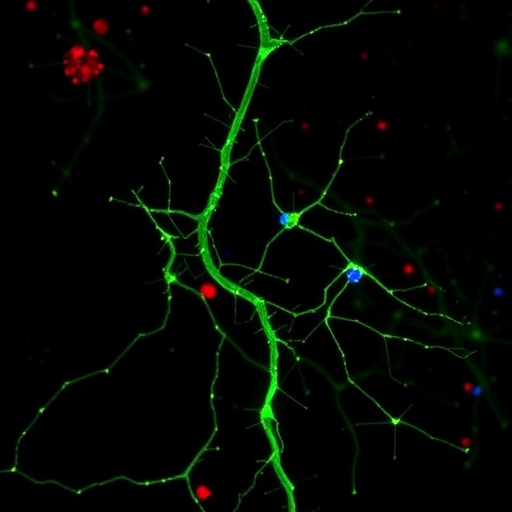Fluorescence-based optical imaging and sensing technologies have emerged as pivotal tools in the landscape of modern medicine, particularly in preclinical and clinical disease diagnosis. Among the myriad advancements in this field, aggregation-induced emission luminogens (AIEgens) stand out, presenting a transformative leap over traditional fluorophores. The unique characteristics of AIEgens, such as their enhanced fluorescence signals when in an aggregated state, have led to heightened interest from researchers and clinicians alike. Unlike conventional fluorescent agents that often suffer from limitations in brightness and stability, AIEgens maintain impressive photostability and exhibit a large Stokes shift, which contributes to clearer imaging in complex biological systems.
The mechanisms that underlie the aggregation-induced emission phenomenon are rooted in the molecular design of AIEgens. When these compounds are diluted in solution, their molecular units are typically in a non-emissive state due to intramolecular motions that dissipate energy. However, upon aggregation, these otherwise mobile units become restricted and lead to a significant increase in fluorescence. This transformation is not just a matter of aesthetics; enhanced fluorescence signals facilitate improved detection of disease markers and pathological changes in cellular environments. This unique property holds immense promise for early-stage diagnosis where subtle changes can be overlooked.
The versatility of AIEgens does not end with enhanced fluorescence. Researchers have exploited their photochemical properties to also enable simultaneous phototherapy, an emerging treatment modality that integrates diagnosis and therapy into a single framework. This capability reflects a significant paradigm shift toward the concept of theranostics — a combined therapeutic and diagnostic approach that could radically change how conditions like cancer are treated. As AIEgens allow for real-time monitoring of treatment responses through imaging, they serve as powerful agents in personalized medicine, where interventions are tailored based on individual patient responses.
.adsslot_tq6GO1Wg3C{ width:728px !important; height:90px !important; }
@media (max-width:1199px) { .adsslot_tq6GO1Wg3C{ width:468px !important; height:60px !important; } }
@media (max-width:767px) { .adsslot_tq6GO1Wg3C{ width:320px !important; height:50px !important; } }
ADVERTISEMENT
Clinical and translational studies involving AIEgens have already shown promising results in the detection of various diseases, including cancer, infections, and cardiovascular disorders. From early-stage diagnosis to monitoring treatment efficacy, AIEgens aid healthcare professionals in navigating the complex parameters inherent in disease pathology. Their ability to target specific cellular processes allows for more tailored approaches to therapies, optimizing both outcomes and patient safety. For instance, in oncology, precise imaging of tumor margins could guide surgical interventions, augmenting traditional techniques with data-driven insights derived from AIE-enhanced fluorescence.
Despite their remarkable properties, the road to broad clinical adoption of AIEgens is not without obstacles. Researchers have encountered limitations in terms of biocompatibility, clearance rates from the body, and the potential for systemic toxicity with certain AIEgen formulations. The development of AIEgens that effectively balance these factors while retaining strong emission properties remains a significant challenge. Addressing these limitations is not merely a matter of technical prowess; it requires an interdisciplinary approach involving chemists, biologists, and clinicians working hand-in-hand to refine and optimize AIEgen designs for accurate and safe human applications.
Functionalization strategies emerge as critical components in the pursuit of making AIEgens suitable for clinical environments. Tailoring the chemical structures of AIEgens can effectively modulate their properties, enhancing their performance and ensuring minimal adverse effects on biological systems. By introducing specific functional groups, scientists can improve solubility in physiological environments, alter uptake mechanisms in target cells, and direct the localization of AIEgens to areas of interest in vivo. This level of customization is essential for expanding the range of applications for AIEgens beyond mere imaging to include quantifiable therapeutic effects and diagnostics in various fields.
The trend towards using AIEgens in phototheranostics opens exciting possibilities for future biomedical applications. Ongoing research continues to illuminate how these innovative materials can be integrated into existing diagnostic workflows and therapeutic protocols. Potential applications extend into other medical fields, including neurology, where the imaging of neural tissue and the monitoring of associated pathologies could greatly benefit from AIE-enhanced visibility. Moreover, their use in detecting infectious agents or monitoring cardiovascular health translates to potentially revolutionary outcomes in preventative medicine.
While many integral aspects of AIEgen technology show promise, it is imperative to maintain an eye on sustainability and eco-friendliness as the materials are produced and utilized in therapeutic settings. Addressing the environmental impact of producing AIEgens and ensuring that their breakdown products do not introduce new hazards into biological systems will be crucial as the technology advances. The incorporation of sustainable practices into the development of AIE-based compounds will not only elevate their acceptance in the medical community but will also ensure compliance with broader ecological responsibility.
The growing adoption of AIEgens as integral components of disease management protocols illustrates the importance of collaboration in advancing this exciting scientific frontier. Partnerships among pharmaceutical companies, academic institutions, and clinical research organizations will catalyze innovation while also providing infrastructures necessary for clinical trials, regulatory approval, and eventual market entry. Feedback from clinical practice will, in turn, refine the strategies used to design and apply AIEgens effectively.
As efforts to bridge the gap between laboratory research and bedside application draw momentum, the potential for AIEgens to revolutionize disease diagnosis and management becomes increasingly tangible. Their unique properties position them as promising candidates not only for researchers but also for those in clinical settings looking to enhance patient care strategies. It is clear that the future of AIEgens in medicine is not just a projection, but a developing reality, as ongoing research strives to optimize their designs and applications.
In summary, the integration of aggregation-induced emission luminogens into clinical practice signifies a major stride toward enhancing diagnostic and therapeutic modalities. The evidence supporting their efficacy points toward a new era in which diseases can be detected earlier and treated more effectively. As researchers continue to overcome current challenges and capitalize on their unique properties, the vision of a fully integrated phototheranostic strategy utilizing AIEgens stands within reach. This forward-thinking approach epitomizes the true potential of modern science to redefine patient care and improve outcomes on a global scale.
With these innovations, the landscape of medical diagnostics and treatment is poised for transformation. The compelling potential of AIEgens serves not only to inspire further research and development but also to foster hope for advancing healthcare solutions that are more accurate, less invasive, and ultimately more successful in combating diseases that impact millions worldwide.
Subject of Research: Aggregation-Induced Emission Luminogens
Article Title: In vivo, clinical and translational aspects of aggregation-induced emission
Article References:
Yan, D., Wang, D. & Tang, B.Z. In vivo, clinical and translational aspects of aggregation-induced emission.
Nat Rev Bioeng (2025). https://doi.org/10.1038/s44222-025-00342-1
Image Credits: AI Generated
DOI: 10.1038/s44222-025-00342-1
Keywords: AIEgens, fluorescence imaging, phototheranostics, disease diagnosis, biomedical applications, biocompatibility, sustainable practices
Tags: aggregation effects on fluorescenceaggregation-induced emissionAIEgens in medical imagingclinical applications of AIE technologyearly-stage disease detectionenhanced fluorescence signalsfluorescence-based optical sensingimproved imaging in biological systemsmolecular design of AIEgensphotostability of fluorescent agentspreclinical disease diagnosistraditional fluorophores limitations





